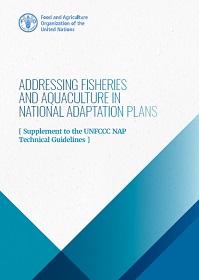Addressing agriculture, forestry and fisheries in National Adaptation Plans – Supplementary guidelines
The Addressing agriculture, forestry and fisheries in National Adaptation Plans – Supplementary guidelines (referred to as the NAP-Ag Guidelines) responds to a call by the Least Developed Group (LEG) of the UNFCCC, inviting international actors to draft sectorial guidelines to the UNFCCC NAP Technical Guidelines.
The NAP-Ag Guidelines aim to support developing countries in:
reducing vulnerability of the agriculture sectors to the impacts of climate change by building adaptive capacities and resilience;
addressing agriculture in the formulation and implementation of NAPs; and
enhancing the integration of adaptation in agricultural development policies, progammes and plans.
The NAP-Ag Guidelines outline four elements and related steps for preparing the agriculture sectors' contributions to NAPs.
Sectoral NAP Supplementary guidelines: forestry and fisheries
Forests and trees provide nature-based solutions for adaptation helping other sectors build resilience. Thanks to their crucial ecosystem services, forests support crops, livestock, and fisheries, as well as prevent flooding and erosion that can threaten infrastructure, economies and people.
To help countries integrate these considerations into adaptation planning, the CGIAR Research Program on Forests Trees and Agroforestry (FTA) and FAO joined forces and developed the Addressing forestry and agroforestry in National Adaptation Plans: Supplementary guidelines (2020). Also available in Spanish.
- Related article on Forests and agroforestry taking its place in NAPs
To support countries integrate fisheries and aquaculture into adaptation planning, FAO developed the Addressing Fisheries and Aquaculture in National Adaptation Plans - Supplement to the UNFCCC NAP Technical Guidelines (2020). These guidelines highlight the nexus between sustainable aquatic food production and climate adaptation.
The users of the NAP-Ag Guidelines are intended to be the following:
Decision-makers
Decision-makers
at the high policy level and across many different sectors, including UNFCCC focal points and the national designated authorities of the GCF; and others planners who may have only limited agriculture expertise.
Authorities and experts within the agriculture sectors
Authorities and experts within the agriculture sectors
who are contributing to climate change adaptation and NAP formulation and implementation, including partners and stakeholders participating in sectoral, national and subnational planning processes and work to mainstream climate change adaptation into different sectors and programmes.
Climate change experts working at the global level
Climate change experts working at the global level
including United Nations, bilateral donors and financing institutions (e.g. GEF and GCF).
Additional resources
Want more information and resources for formulating and implementing NAPs?
Refer to the NAP-Ag Knowledge Tank, the first holistic collection and categorization of key tools and resources for adaptation planning integrating the agriculture sectors, powered by a search engine.




